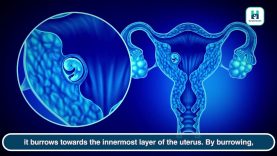Implantation Pain कब, कैसा और कहाँ दर्द होता है | Implantation Cramps vs Period Cramps | Is the implantation process painful? | How is the Pain Different From Period Cramps?
- 142.30K
- 11 months ago
Dr. Heena Chawla
Dr. Heena Chawla
Implantation Pain कब, कैसा और कहाँ दर्द होता है | Implantation Cramps vs Period Cramps | Is the implantation process painful? | How is the Pain Different From Period Cramps?
Implantation Pain, In this video, SimpliHealth expert, Dr. Heena, Consultant Gynaecologist and Laparoscopic Surgeon at Apollo Clinic and CHD City Hospital, Sector- 8 Chandigarh, talks about the implantation process and answeres questions like:
- What is Implantation cramps or pain?
- Are these early signs of pregnancy?
- How can you differentiate it from cramps from periods?
Where can one feel implantation cramps?
Implantation pain can occur in the lower abdomen as pain or cramps. By implantation, we mean the embryo travels through fallopian tubes to the uterus after fertilisation. Inside the uterus, it burrows towards the innermost layer of the uterus. By burrowing, fertilised embryo implants in the inner lining of the uterus. These pains may occur in the lower abdomen centre or may shift to the left or right side of the abdomen. If the female feels pain at the centre, it is probably implanting in the fundus or upper uterus. But if it’s implantation on the left or right sides of the wall, then the pain may shift to the left and right sides of the wall. Implantation may last for a few hours to 2 days. Mostly it heals on its own. Sometimes implantation pain may accompany spotting, which we usually call implantation bleeding.
Implantation bleeding
There can be pinkish and brownish discharge during the time of implantation. It is not like severe pain. Instead, it’s mild cramps in the stomach. Avoid any painkillers during this time. Implantation cramps doesn’t cause any ill effects on the baby.
How can we know that this pain is implantation cramps?
There is a specific time for this pain. It occurs after 6-12 days post ovulation. The embryo takes this much time from fertilisation to travel to implantation in the uterus. This whole process is 6-12 days. If the women’s cycle is 28 days and the ovulation occurs on 14 days, then most probably, the implantation pain will be at 20 -26 days. Or if the cycle is of 32 days, then ovulation would be on 18 days and the implantation pain 24-30 days. And in the prolonged cycles of 35 -40 days, the ovulation would occur near the 21st day, and pain would start in 27 to 33 days.
Another crucial query that patients often ask is how we can differentiate implantation pain from period cramps.
How to differentiate between period cramps and implantation cramps
?
See, it is straightforward. Implantation cramps comes with early pregnancy symptoms, like tiredness, nausea, fatigue, constipation, mood swings, frequent urination, and lower back ache. And mostly, we are pretty familiar with periods of pain. Because we feel the same type of pain during every cycle, it also occurs before 1-2 days of onset. At the same time, the implantation pain starts from 6-12 post ovulation.
In contrast to periods, implantation pain occurs within five days. Also, period cramps mainly happen immediately on the onset of periods 1-2 days before. Also, period cramps are more severe since the uterus is a muscle structure. The contraction to shed up the muscle layer causes pain. It lasts for a long time. In addition, it is not necessary to have nausea, constipation, and fatigue during periods of cramps. Hence one can easily distinguish between period cramps and implantation pain.
Ultimately, in conclusion, being pregnant is another mode of meeting the love of your life. So enjoy this journey. Take care of your health. Be safe.















Comments (0)